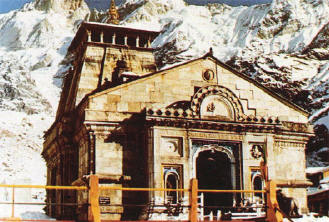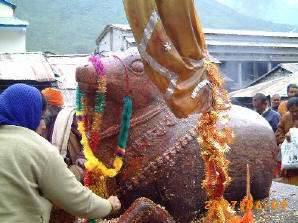|
Kedarnath
Amidst the dramatic mountainscapes of the majestic Kedarnath range stands
one of the twelve ‘Jyotirlingas’ of Kedar or Lord Shiva. Lying at an
altitude of 3584 mts. on the head of river Mandakini, the shrine of
Kedarnath is amongst the holiest pilgrimages for the Hindus.
The origin of the revered temple can be found in the great epic -
Mahabharata. According to legend, the Pandavas sought the blessings of Lord
Shiva to atone their sins after the battle of Mahabharata. Lord Shiva eluded
them repeatedly and while fleeing took refuge at Kedarnath in the form of a
bull. On being followed, HE dived into the ground, leaving behind HIS hump
on the surface. This conical protrusion is worshipped as the idol in the
shrine.The remaining portions of Lord Shiva are worshipped at four other
places - the arms (bahu) at Tungnath, mouth (mukh) at Rudranath, navel (nabhi)
at Madmaheshwar and hair (jata) at Kalpeshwar. Together with Kedarnath,
these places are known as the Panch Kedar.
The lingam at Kedarnath is pyramidal, unlike its usual form. A status of
Nandi – the celestial bull stands at the entrance of the temple and
exquisitely carved images adorn the interiors of the temple.
During the winters, the shrine is submerged in snow and hence is closed.
The ideal time to visit is between May to October. Kedarnath is reached
through a 14 km. long trek from Gaurikund.
Location
Kedarnath is situated in the Uttar Kashi district of the northern state of
Uttaranchal. Very close to the Indo-Chinese border, it is the source of the
Mandakini River. It is couched in the scenic locales of the Garhwal
Himalayas at 3583 meters above sea level. It is very cold in the winters
with the ground being covered with snow. In the summers, the mercury barely
crosses the 20°C mark. The place experiences about 150 cm of rainfall during
the monsoons and so the best time to visit is between May and October.
Kedarnath is near to Rishikesh (234 km) and Dehradun (250 km).
History
According to legend, Lord Shiva wished to elude the Pandavas, who had come
to seek penitence for having killed their kin in the battle of Kurukshetra.
He took refuge in Kedarnath in the form of a bull. Bhima, one of the Pandava
brothers, found Shiva amongst a herd of cattle. Having identified the
meanest and most arrogant of the herd as Shiva, Bhima is said to have
grabbed him by the hindquarters. What remains at the shrine in Kedarnath is
the rear end of the bull, with the rest of its body scattered throughout the
Garhwal. Shiva dived into the ground leaving behind him a hump on the
surface. This conical protrusion is worshipped as the idol. It is the main
site of the Panch Kedar temples.
There are Four Other
Kedars
- Madhyamaheshwar
- Tunganath
- Kalpeshwar
- Rudranath
Three of these (barring Kalpeshwar) are
in mountain meadows at higher altitudes than Kedarnath. The climb to
Rudranath is the most strenuous though worth the trouble, as this meadow
is one of the finest in Garhwal.
Mythological Myth
Legend has it that when the Pandavas sought penance following the great
war of the Mahabharata they came in search of Lord Shiva. Arriving at this
site they found that Shiva had elusively taken the form of a bull. Bhim
the strongest of the Pandavas went after Shiva who dived deep into the
ground. Only Shiva's tail was left in Bhim's hand. This spot is known as
the Kedarnath and is also considered the main Kedar. The rest of Shiva's
body emerged at four other places in Garhwal - Tunganath, Madhyamaheshwar,
Kalpeshwar and Rudranath.
These five Kedars are worshipped as Panch Kedars
- Tungnath
Shiva's arms came out at Tungnath. The Tungnath temple is at an altitude
of 3,680 m and is the highest Shiva shrine among the Panch Kedars.
However it is the easiest to reach from Chopta, the nearest road head.
- Rudranath
Shiva's face is worshipped at the Rudranath temple. It is about 2,286 m
above sea level and is 23 km from Gopeshwar. 5 km of the distance is
motor able and 18 km is on foot. The trek passes through wild orchards
and picturesque bugyals (meadows) and involves trekking over high ridges
(sometimes 4,000 m). The temple site provides magnificent views of Hathi
Parvat, Nanda Devi, Nanda Ghungti, Trishuli and many other peaks. There
are a number of holy kunds or ponds near the Rudranath temple like
Suryakund, Chandrakund, Tarakund. The entire area is utterly enchanting
and unmatched in scenic beauty. Anusuya Devi temple is located on the
trek to Rudranath involving an additional trek of 3km.
General Information :-
Area : 3 sq. km.
Climate :
Winter: Sep. to Nov. cold during the day and chilly at night.
Summer: May -
August- Cool during the day and cold at night.
Rainfall : 1475
mm.
Best Season :
May to October except monsoon.
Clothing : Light
woollens in summer. Heavy woollens in winter.
Language :
Hindi, Garhwali and English.
Attractions of
Kedarnath
-
Kedarnath Temple
The present temple, built in 8th century A.D. by Adi Guru Shankaracharya
lies adjacent to the site of an ancient temple built by Pandavas. The
walls of the exquisitely architectured temple are embellished with figures
of deities and scenes from mythology. The temple has a conical lingam -
the main idol, a statue of Nandi - the celestial bull, a 'garbha grab' for
worship and a 'mandap' for assemblies of piligrims and visitors. The
temple is believed to be more than 1000 years old.
-
Shankaracharya Samadhi
Behind the Kedarnath Temple lies the samadhi or the final resting place of
Adi Guru Shankaracharya. It is believed, after establishing the four dhams
in India, he went for his samadhi at an early age of 32 years.
Excursions
Chorabari (Gandhi Sarovar) (2 kms.)
A small lake from where Yudhishthir, the eldest of the Pandavas, is believed
to have departed to heaven. The floating ice on the sparkling waters of the
lake is a fascinating sight.
-
Vasuki Tal (6 kms.)
A picturesque lake, 4,135 mts. above sea level is encircled by lofty
mountains and offers a commanding view of the Chaukhamba peaks.
-
Gaurikund (14 kms.)
The trekking base to Kedarnath. A temple dedicated to Gauri and thermal
springs of medicinal value are noteworthy.
-
Sonprayag (20 kms.)
The confluence of Son Ganga and Mandakini rivers. The road to
Triyuginarayan diverts from here.
-
Triyuginarayan (25 kms.)
A 5 kms. trek from Sonprayag, it is the mythological venue of the marriage
of Lord Shiva and Goddess Parvati.An eternal flame, which is said to have
been a witness to the marriage, burns in front of the temple even today.
-
Guptkashi (49 kms.)
The temples of Ardhnarishwar and Vishwanath are noteworthy.
-
Ukshimath (60 kms)
Winter home of the deity of the Kedarnath Temple and the seat of the Rawal
of Kedarnath.
-
Agastyamuni (73 kms.)
Famous for the temple dedicated to sage Agastya.
-
Chandrashila (93 kms.)
The Chandrashila peak provides a rare view of snow-clad peaks. The
rhododendron Forests and alpine meadows dominate the trek fromTungnath to
Chandrashila.
-
Deoria Tal (68 kms.)
Sari village is the last bus terminus on Chopta-Ukhimath road from where a
2 kms. trek leads to Deoria Tal. This beautiful lake at an altitude of
2,438 mts. gives the spectacular reflection of snow capped peaks in the
lake water. Ideal spot for angling and bird watching.
Photos of
Badrinath
 |
 |
|
Kedarnath Temple |
Nandi - Kedarnath |
How to Reach Kedarnath:
|
Air |
: |
Nearest airport is Jolly Grant, Dehradun,
239 km.
|
|
Rail |
: |
Nearest railway station is Rishikesh,
221 km.
|
|
Road |
: |
Kedarnath is approachable on foot, 14 km
from Gaurikund, which is connected by road with Rishikesh, Kotdwar,
Dehradun, Haridwar and other important hill stations of Garhwal and
Kumaon hills.
|
|
Local Transport |
: |
Horses, dandies and ponies are available
at Gaurikund for going and carrying luggage to Kedarnath.
|
ACCOMMODATION
Dharamshalas, Ashrams, Cottages and Tourist Rest House offer a
comfortable stay.
An Important Note
During the winters, the shrine is submerged in snow and hence is closed. The
ideal time to visit is between May to October. Kedarnath is reached through
a 14 km. Long trek from Gaurikund.
Tourist Information Centre ( Kedarnath )
Rishikesh (Yatra Office), AGM
(Tourism), GMVN Ltd., Tourist Information Centre,
(Advance Reservation Centre)
Shail Vihar, Haridwar By Pass Road, Rishikesh Pin: 249201.
Tel.: 0135-2431793, 2431783, 2432648, 2430799.
Fax: 0135-2430372.
Email: yatra@gmvnl.com, yatraoffice@sancharnet.in.
|

